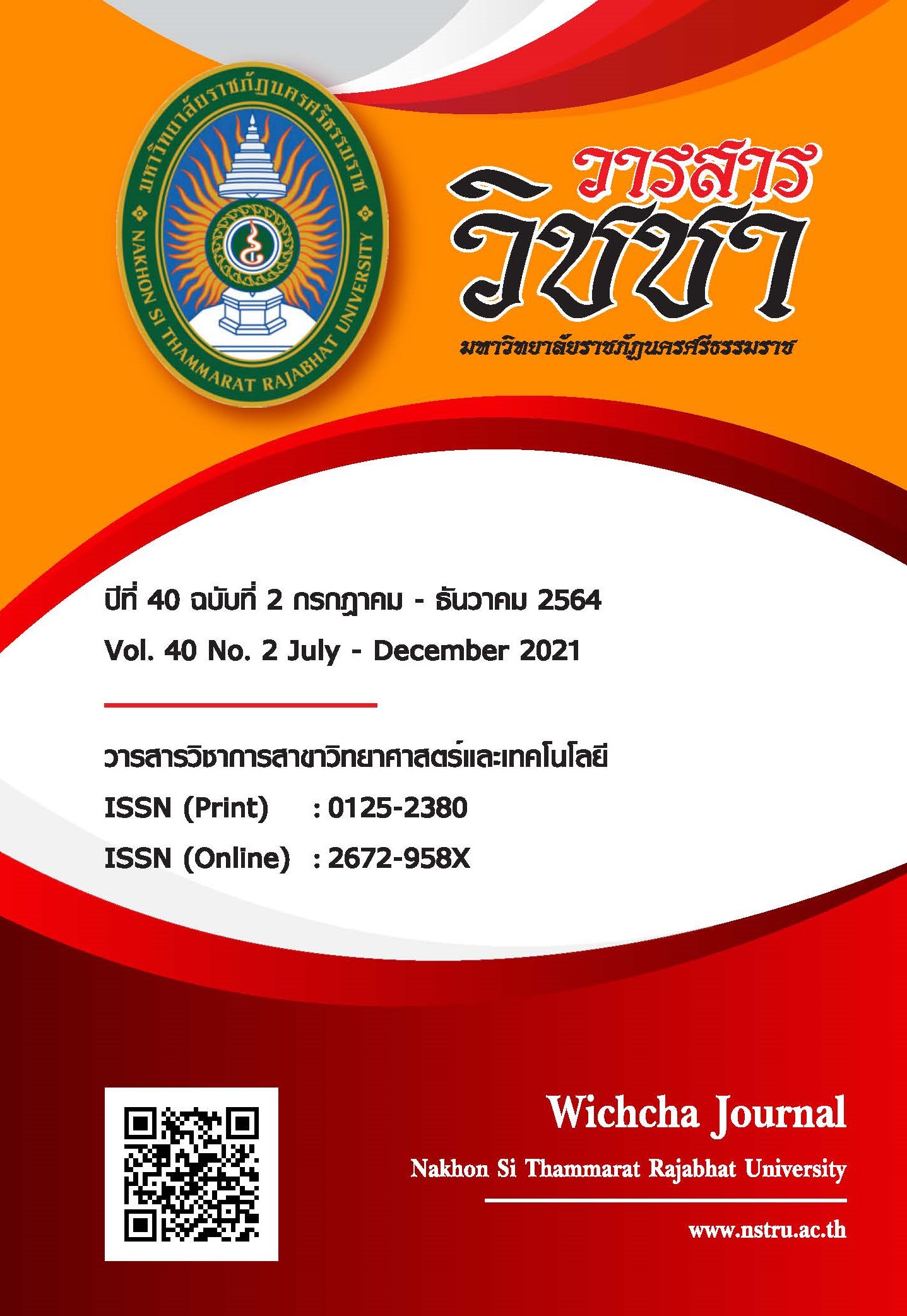Diversity of Macrobenthic Fauna and its Relationship with Environmental Factors in the Yom River ความหลากหลายของสัตว์หน้าดินขนาดใหญ่และความสัมพันธ์ต่อปัจจัยสิ่งแวดล้อมในแม่น้ำยม
Main Article Content
Abstract
Studies on the diversity of macrobenthic fauna and environmental factors were carried out to assess the quality of water resources and investigate the correlation of environmental factors with macrobenthic fauna in the Yom River. The field surveys were conducted at 16 sampling stations. Samples were collected in the winter season (January 2018), summer season (April 2018), and the rainy season (July 2018). The results showed that forty-seven families from 3 phyla of macrobenthic fauna were identified. The dominant benthic fauna group were Unionidae (10.67%) Viviparidae (10.46%) Chironomidae (8.22%) and Tubificidae (7.44%). The Shannon-Wiener diversity index Magalef index and Evenness index were 2.07±0.07, 0.67±0.09, and 1.87±0.09, respectively. Canonical correspondence analysis revealed that Diptera, Haplotaxida, and Lumbriculida showed a positive correlation with some parameters such as pH, water temperature, turbidity, BOD, chlorophyll a, ammonia, nitrite, nitrate, and total organic matter, while Hemiptera, Odonata, Decapoda, Trichoptera, and Ephemeroptera showed the positive correlation with total dissolved solids, conductivity, alkalinity and transparency. After assessing the water quality using the ASPT value (mean value of 5.11±0.85) and comparing it with the standard index of surface water quality, it was concluded that water quality reached mesotrophic status and surface water quality CLASS 3. These results can be beneficial in monitoring water quality and controlling effluents from various activities to conserve the water resources in the Yom River.
Article Details
เนื้อหาและข้อมูลในบทความที่ลงตีพิมพ์ในวารสารวิชชา มหาวิทยาลัยราชภัฏนครศรีธรรมราช ถือเป็นข้อคิดเห็นและความรับผิดชอบของผู้เขียนบทความโดยตรง ซึ่งกองบรรณาธิการวารสารไม่จำเป็นต้องเห็นด้วยหรือร่วมรับผิดชอบใด ๆ
บทความ ข้อมูล เนื้อหา รูปภาพ ฯลฯ ที่ได้รับการตีพิมพ์ในวารสารวิชชา มหาวิทยาลัยราชภัฏนครศรีธรรมราช ถือเป็นลิขสิทธ์ของวารสารวิชชา มหาวิทยาลัยราชภัฏนครศรีธรรมราช หากบุคคลหรือหน่วยงานใดต้องการนำข้อมูลทั้งหมดหรือส่วนหนึ่งส่วนใดไปเผยแพร่ต่อหรือเพื่อการกระทำการใด ๆ จะต้องได้รับอนุญาตเป็นลายลักษณ์อักษรจากวารสารวิชชา มหาวิทยาลัยราชภัฏนครศรีธรรมราชก่อนเท่านั้น
The content and information in the article published in Wichcha journal Nakhon Si Thammarat Rajabhat University, It is the opinion and responsibility of the author of the article. The editorial journals do not need to agree. Or share any responsibility.
References
กรมควบคุมมลพิษ. (2546). คู่มือการติดตามตรวจสอบและประเมินคุณภาพน้ำในแหล่งน้ำจืดผิวดิน. กรุงเทพฯ: สำนักงานจัดการคุณภาพน้ำ.
กัญญาณัฐ สุนทรประสิทธิ์ ศิริลักษณ์ วลัญช์เพียร และสันธิวัฒน์ พิทักษ์พล. (2556). ความหลากหลายของแมลงน้ำในแม่น้ำอิง. วารสารแก่นเกษตร, 41(1), 142-148.
กัญญาณัฐ สุนทรประสิทธิ์ ศิริลักษณ์ วลัญช์เพียร สุกัญญา ฟักแก้ว และภัทมาศ อ่ำทอง. (2560). การใช้แมลงน้ำเป็นตัวบ่งชี้คุณภาพน้ำในลำห้วยสาขาของหนองเล็งทรายจังหวัดพะเยา. วารสารแก่นเกษตร, 45(4), 653-662.
กิติยา ถาวโรฤทธิ์ พงษ์พันธ์ สุขสุพันธ์ และนฤมล แสงประดับ. (2560). ความหลากหลายของแมลงชีปะขาว แมลงสโตนฟลายและแมลงหนอนปลอกน้ำในเขตรักษาพันธุ์สัตว์ป่าฮาลา-บาลา จังหวัดนราธิวาส. วารสารมหาวิทยาลัยนราธิวาสราชนครินทร์, 1(3), 149-161.
ฐิติมน ญาณพืช และสุชาติ เหลืองประเสริฐ. (2562). การประเมินความสัมพันธ์ของแพลงก์ตอนพืชกับคุณภาพน้ำในแม่น้ำเจ้าพระยา. วิศวกรรมสาร มก, 107(32), 65-72.
ณัฐธิดา คลังกลาง และเรวดี โรจนกนันท์. (2554). การใช้สัตว์ไม่มีกระดูกสันหลังหน้าดินเพื่อเป็นดัชนีชี้วัดคุณภาพน้ำทางชีวภาพโดยการประยุกต์ใช้ belgian biotic index (BBI) กรณีศึกษาลําน้ำใกล้โรงงานผลิตน้ำมันปาล์มในอําเภอหนองใหญ่จังหวัดชลบุรี. ใน การประชุมสัมมนาทางวิชาการการนำเสนอผลงานวิจัยระดับบัณฑิตศึกษา ครั้งที่ 12 (หน้า 765-773). ขอนแก่น: มหาวิทยาลัยขอนแก่น.
ณัฐธิดา จันทวงศ์ และสุปิยนิตย์ ไม้แพ. 2563. ความหลากชนิดและการกระจายของโรติเฟอร์และคลาโดเซอแรนในแหล่งน้ำจืด อำเภอกำแพงแสน จังหวัดนครปฐม. วารสารวิชชา มหาวิทยาลัยราชภัฏนครศรีธรรมราช, 39(2), 45-59.
ทินพันธุ์ เนตรแพ. (2556). ความหลากหลายของสัตว์พื้นท้องน้ำในแม่น้ำจังหวัดนครสวรรค์. วารสารวิชาการวิทยาศาสตร์และเทคโนโลยี มหาวิทยาลัยราชภัฏนครสวรรค์, 5(5), 1-8.
บุญเสฐียร บุญสูง. (2557). คู่มือจำแนกตัวอ่อนแมลงชีปะขาว แมลงสโตนฟลายและแมลงหนอนปลอกน้ำในประเทศไทย. กรุงเทพฯ: มหาวิทยาลัยเกษตรศาสตร์.
ปฏิพัทธ์ สันป่าเป้า สุพัฒน์ พลซา ปิยวัฒน์ ปองผดุง และวิทยา ทาวงศ์. (2560). ความหลากหลายชนิดของแพลงก์ตอนพืชและความสัมพันธ์ต่อคุณภาพน้ำในอ่างเก็บน้ำแม่ถาง จังหวัดแพร่. วารสารแก่นเกษตร, 45(4), 663-674.
พิชยา ชูมก. (2557). ความหลากหลายของสาหร่ายขนาดใหญ่แพลงก์ตอนพืชแพลงก์ตอนสัตว์และไดอะตอมพื้นท้องน้ำและการใช้เป็นดัชนีบ่งชี้คุณภาพน้ำในแม่น้ำลี้จังหวัดลําพูน. พิฆเนศวร์สาร, 10(2), 81-97.
พิชาศิษฐ์ แสงเมฆ และสิทธิชัย ฮะทะโชติ. (2564). ผลของปัจจัยสิ่งแวดล้อมต่อประชาคมสัตว์หน้าดินในหนองหารจังหวัดสกลนคร. วารสารวิจัยมหาวิทยาลัยเทคโนโลยีราชมงคลศรีวิชัย, 13(1), 107-124.
วิมลรัตน์ บุตรดาซุย เจนจิรา หมื่นเร็ว และสุขทัย พงศ์พัฒนศิริ. (2556). การเปลี่ยนแปลงคุณภาพน้ำผิวดินในกว๊านพะเยา (ลุ่มน้ำแม่โขง). วารสารนเรศวรพะเยา, 6(2), 111-115.
สถาบันสารสนเทศทรัพยากรน้ำและการเกษตร. (2555). ฐานข้อมูลพื้นฐานลุ่มน้ำยม. กรุงเทพ: สถาบันสารสนเทศทรัพยากรน้ำและการเกษตร (องค์การมหาชน).
สมสงวน ปัสสาโก จุไรรัตน์ คุรุโคตร และชมภู่ เหนือศร. (2561). คุณภาพน้ำและความหลากหลายของสัตว์หน้าดินในแม่น้ำชี. วารสารเกษตรพระวรุณ, 15(1), 156-167.
สรณรัชฎ์ กาญจนะวณิชย์. (2545). คู่มือหาชื่อสัตว์เล็กน้ำจืด โครงการนักสืบสายน้ำ. กรุงเทพฯ: บริษัทอมรินทร์พริ้นท์ติ้งแอนด์พับลิชชิ่ง จำกัด (มหาชน).
สันธิวัฒน์ พิทักษ์พล กัญญาณัฐ สุนทรประสิทธิ์ และศิริลักษณ์ วลัญช์เพียร. (2557). คุณภาพน้ำและความหลากหลายของแพลงก์ตอนพืชในแม่น้ำอิง. วารสารแก่นเกษตร, 42(ฉบับพิเศษ 1), 778-784.
อำพร ศักดิ์เศรษฐ ณิชารินทร์ แก้วฤทธิ์ และชไมพร แก้วศรีทอง. (2557). การประเมินคุณภาพน้ำด้วยวิธี AARL-PP Score ของแพลงก์ตอนพืชชนิดเด่น และ BMWP (THAI) Score ของสัตว์หน้าดินในลุ่มน้ำปากพนัง จังหวัดนครศรีธรรมราช. วารสารการประมง, 67(1), 29-42.
อิสระ ธานี. (2557). การใช้สัตว์ไม่มีกระดูกสันหลังหน้าดินขนาดใหญ่เพื่อการติดตามตรวจสอบทางชีวภาพ. วารสารวิจัย มสด สาขาวิทยาศาสตร์และเทคโนโลยี, 7(1), 125-137.
APHA, AWWA and WEF. (2012). Standard methods for the examination of water and wastewater. (22nd ed). Water Environment Federation. Washington DC: American public health association.
Boonsoong, B. and Sangpradub, N. (2002). Impact of intensive fish cage culture on benthic macroinvertebrates in Chi River, Northeast, Thailand. KKU Science Journal, 30(4), 228-240. (in Thai)
Brandt, R.A.M. (1974). The non-marine aquatic mollusca of Thailand. Archiv für Molluskenkunde, 105, 1-423.
De Lima, F.B., Schäfer, A.E. and Lanzer, R.M. (2013). Diversity and spatial and temporal variation of benthic macroinvertebrates with respect to the trophic state of Lake Figueira in the South of Brazil. Acta Limnologica Brasiliensia, 25(4), 429-441.
Edmonson, W.T. (1959). Freshwater biology. (2nd ed). New York: John Wiley and Sons, Inc.
Ishtiyaq, A.N., Anisa, B.K. and Abdul, H. (2017). Evaluation of seasonal variability in surface water quality of Shallow Valley Lake, Kashmir, India, using multivariate statistical techniques. Pollution, 3(3), 349-362.
Mustow, S.E. (2002). Biological monitoring of rivers in Thailand and application of the BMWP score. Hydrobiologia, 479(1), 191-229.
Parsons, T.R, Maita, Y. and Lalli, C.M. (1984). A manual of chemical and biochemical methods for seawater analysis. Oxford: Pergamon press, Inc.
R Development Core Team. (2009). R: A language and environment for statistical computing. Retrieved 5 October 2021, from: http://www.R-project.org/.
Sangpradub, N. and Boonsoong, B. (2006). Identification of freshwater invertebrates of the Mekong River and its tributaries. Vientiane: Mekong River Commission.
Silva, F.L., Moreira, D.C., Ruiz, S.S. and Bochini, G.L. (2009). Diversity and abundance of aquatic macroinvertebrates in a lotic environment in Midwestern São Paolo State, Brazil. Ambi-Agua, Taubaté, 4(1), 37-44.
Soontornprasit, K. (2012). Use of aquatic insects as bioindicators of water quality in Kwan Phayao, Phayao Province. Journal of Community Development Research, 5(1), 15-24. (in Thai)


